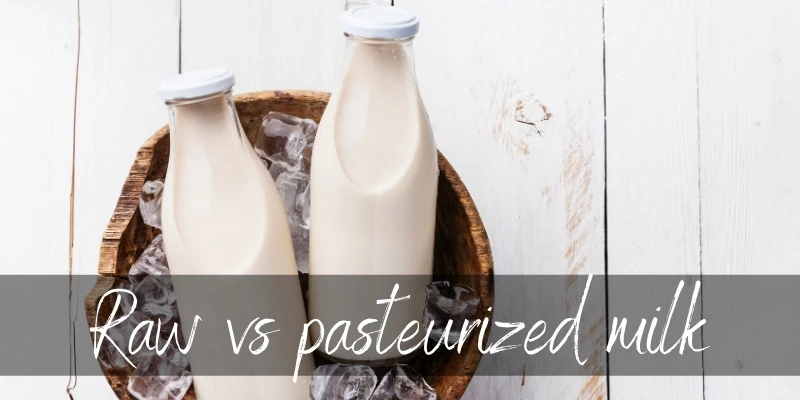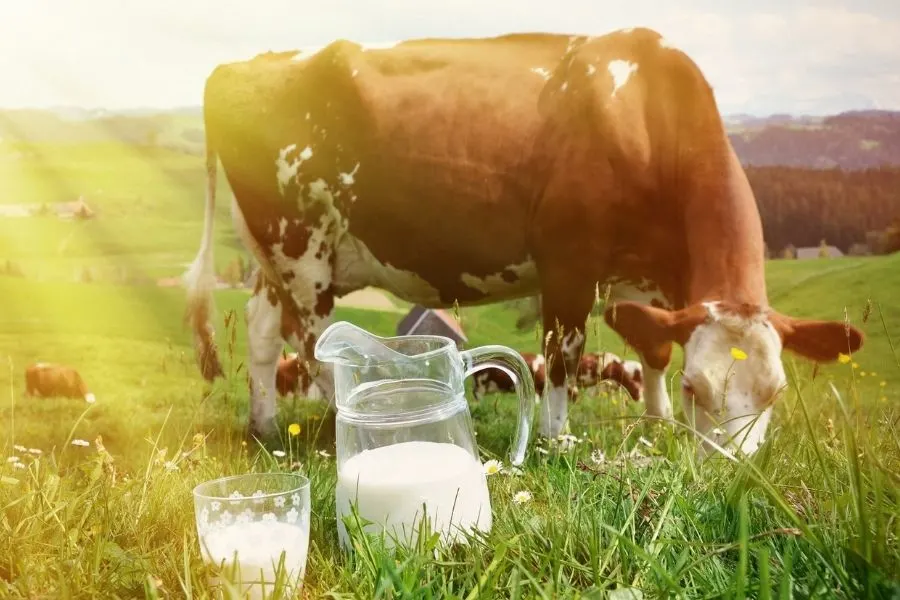If you’re in the dairy aisle you might be staring down two very different milk cartons. One says raw, the other pasteurized. What do they even mean ? Isn’t all milk the same ?
Well, actually milk is often split between raw milk and pasteurized milk. There’s a few significant differences between them so let’s see.

Raw vs pasteurized milk
The main difference between raw and pasteurized milk is that raw milk is just as it comes from the cow, while pasteurized milk has nearly all bacteria and pathogens removed and is considered safer.
Pasteurized milk may be skimmed, while raw milk usually comes in full fat. You have a higher chance of finding real, raw milk at a farmer’s market or a small grocery store than a big supermarket.
And finally, there is a big difference in shelf life. Pasteurized milk is almost completely sterile, so its shelf life and be very long if unopened. Raw milk can and will expire in less than a week, since it is an untreated animal product.
Okay, now let’s talk a bit about each milk type – raw and pasteurized – so we can get our definitions straight.
What is raw milk ?
Raw milk is the milk that comes straight from the cow and ahs not been touched in any way. Not all cows are the same, and the fat percentage in the milk varies form 3 to 6%. There are slight variations in taste, and also in the hue depending on what and how the cows were fed.

For example a cow fed mostly corn will have a milk that has an off-white, creamy color from the beta carotene in the corn. Meanwhile, a cow fed only grass will have a paler milk. There is no significant nutrient difference between the two, just what is available for feed.
Raw milk – we’re assuming cow’s milk but this applies to any animal milk – comes with all the bacteria and scents that the animal naturally has. In this way, it’s very different to what most people think of when they imagine a glass of milk.
What is pasteurized milk ?
Pasteurized is raw cow milk that’s been heated at various temperatures for a short duration of time, to kill off any bacteria or pathogens present in the milk. Some bacteria remain, but in a much smaller number.
This milk is then packaged into different storage types, but the most common and most useful is the cardboard, aluminum, and plastic milk cartons. Those are sealed and are airtight, and will keep the longest.
There are four ways to pasteurize milk. In America the most common is HTST (high temperature, short time), while in Europe the most common is UHT (ultra high temperature).
Pasteurized milk is often homogenized, meaning it’s run through a very fine sieve to make all the butterfat globules the same size. This means they won’t separate and rise to the surface of the milk, to create a thick layer of cream. The milk stays the same, and can keep for up to 6 months (depending on pasteurization type).
Alright, now let’s compare those differences in detail, because some folks may have a whole lot of questions about why milk is processed, and why raw milk isn’t as good. So let’s see.
Read also: Why Is Milk Pasteurized ?
Pasteurized milk has a longer shelf life
Because pasteurized milk has nearly all the bacteria killed off, there’s much less of a chance of it spoiling, even when opened for a few days.
After all, what spoils milk is the bacteria that eats up the lactose, and creates lactic acid, which in turn curdles the milk. Once that happens and the curds are not used to make cheese, the protein in the curds starts to break down, leading to that awful taste and smell rotten milk gets.
So once most of the bacteria is removed, the speed at which it multiplies and spoils the milk is reduced. It’s then helped by the sterile packaging, which makes sure the air in the facility is sterile, as are the cartons.
The milk has a shelf life from 90 days to 6 months, depending on the exact pasteurization method and how well it’s been stored. UHT milk is good for 6 months, unopened, at room temperature.
Meanwhile, raw milk has all the aforementioned bacteria culture and it will go bad much faster. It’s got a very short shelf life – up to 3 days – since it can curdle very quickly. Because of this, you’ll often see raw milk at a premium price.
Raw milk has the original milk taste
An upside to raw milk is the taste. Yes, raw milk is full fat milk and it will always have that animal taste and smell. It’s much closer to the original milk. In fact, it pretty much is the original milk from the farm, except the cows are maybe cleaner.
The high fat content brings so much more flavor to the milk, but don’t be fooled. It’s no 10%, the most milk can go up to is about 6%, and that’s not every milk from ever cow.
Pasteurized milk usually comes in 3 fat percentages: 3.2% (or 3.5 in Europe), 1.5%, and 0.1% (skim milk). All that fat is used to make cream or cream cheese, it’s not wasted at all.
In our very personal opinion, this division by fat percentages is incredibly useful since the fat content can really make or break a recipe. And if you’re a barista, you know you’ve got much more of a chance of getting the perfect latte with 3.2, as opposed to 1.5.
And to cover one last point in terms of taste. Pasteurized milk is essentially boiled milk, that has then been rapidly cooled. Some people like the taste of boiled milk more than raw milk. Some like raw milk better. Just know that this is a clear difference between the two.
Pasteurized milk poses less health risks
The first concern that gave birth to the idea of pasteurized milk was the health risks. Raw milk comes with all the bacteria the cow normally has, nothing wrong about that.

It’s just that the potential for customer complaints (I bought this milk from you, why is it rotten ?), lawsuits, and any digestive issues is much, much lower for pasteurized milk.
Raw milk carries all those risks, and it’s generally safer to boil milk anyway. Of course, there are raw milk advocates that argue for raw milk as it has more enzymes and beneficial bacteria than pasteurized milk.
The FDA has since debunked that, as you can read here. Probiotics and gut-friendly enzymes are much easier and safer to ingest from yogurt, than from raw milk that may also contain other, harmful bacteria.
Raw milk is illegal in some places
Raw milk is a bit of a debate actually. There are states and countries where selling raw milk is actually illegal, such as Canada, Scotland, Norway, Sweden, Finland, Denmark, and Australia. Other countries allow the sale of raw milk directly to consumers, but under very strict rules and food safety tests, like the European Union, New Zealand, Ireland, and America.
Both milks can be used to make dairy products
No matter what kind of milk you buy, you can use both to make cheese. Even pasteurized milk can be used for dairy products, especially when starter cultures are introduced.
You can make your own pasteurized milk
If you bought raw milk and want to make it completely safe, give it a quick boil. The whole point of pasteurization is to kill of harmful bacteria through heat. By boiling milk for a half minute. You may need to keep putting milk on and off the heat, since it will rise and attempt to spill all over.
Just be careful when you do this, because you then need to store the boiled milk in a clean container and it still won’t have a very long shelf life. There’s a reason this process is done with machines and handled industrially.
Read Also:Do Scrambled Eggs Need Milk ?
Can you drink pasteurized milk without boiling ?
Yes, you can safely drink pasteurized milk without boiling it. It’s already been heated, so it’s safe. That being said, you can still boil it if you want to or need to. It will behave just the same.

